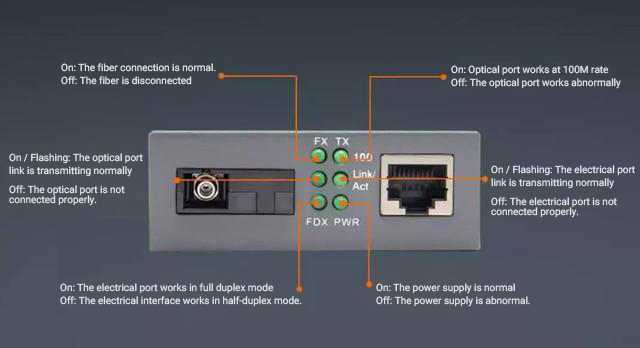When weak current projects encounter long-distance transmission, fiber optics are often used. Because the transmission distance of optical fiber is very long, in general, the transmission distance of single-mode fiber is more than 10 kilometers, and the transmission distance of multi-mode fiber can reach up to 2 kilometers.
In fiber optic networks, we often use fiber optic transceivers. So, how to connect fiber optic transceivers? Let’s take a look together.
First, the role of fiber optic transceivers
① The optical fiber transceiver can extend the transmission distance of Ethernet and extend the coverage radius of Ethernet.
② The optical fiber transceiver can switch between 10M, 100M or 1000M Ethernet electrical interface and optical interface.
③ Using fiber optic transceivers to build a network can save network investment.
④ Optical fiber transceivers make the interconnection between servers, repeaters, hubs, terminals and terminals faster.
⑤ The optical fiber transceiver has a microprocessor and a diagnostic interface, which can provide various data link performance information.
Second, which transceiver does the optical transceiver have and which one does it receive?
When using optical fiber transceivers, many friends will encounter such questions:
1.Do optical fiber transceivers have to be used in pairs?
2.Is the optical fiber transceiver divided into one for receiving and one for transmitting? Or can only two optical transceivers be used as a pair?
3. If the optical fiber transceivers must be used in pairs, is it necessary that they are of the same brand and model? Or can any brands be used in combination?
Answer: Optical fiber transceivers are generally used in pairs as photoelectric conversion devices, but it is also possible to pair fiber optic transceivers with fiber switches, fiber optic transceivers and SFP transceivers. In principle, as long as the optical transmission wavelength is the same The signal encapsulation format is the same and both support a certain protocol to achieve optical fiber communication.
Generally, single-mode dual-fiber (two fibers are required for normal communication) transceivers are not divided into the transmitting end and the receiving end, and can be used as long as they appear in pairs.
Only a single-fiber transceiver (one fiber is required for normal communication) will have a transmitting end and a receiving end.
In other words, different rates (100M and Gigabit) and different wavelengths (1310nm and 1300nm) cannot communicate with each other. In addition, even if a single fiber transceiver and a dual fiber of the same brand are paired, it is not possible to communicate with each other. Interoperable.
So the question is, what is a single fiber transceiver and what is a dual fiber transceiver? What’s the difference between them?
What is a single-fiber transceiver? What is a dual-fiber transceiver?
The single-fiber transceiver refers to a single-mode optical cable. The single-fiber transceiver uses only one core and both ends are connected to this core. The transceivers at both ends use different optical wavelengths, so they can be transmitted in one core Light signal.
A dual-fiber transceiver uses two cores, one for transmission and one for reception, and one end must be inserted at the other end, and the two ends must be crossed.
1.Single fiber transceiver
The single-fiber transceiver must implement both the transmitting function and the receiving function. It uses the wavelength division multiplexing technology to transmit and receive two optical signals with different wavelengths on one optical fiber.
Therefore, the single-mode single-fiber transceiver is transmitted through a core optical fiber, so the transmitting and receiving light are transmitted through a fiber core at the same time. In this case, to achieve normal communication, two wavelengths of light must be used to distinguish.
Therefore, the optical module of a single-mode single-fiber transceiver has two wavelengths of emitted light, usually 1310nm / 1550nm. In this way, there are differences between the two ends of a pair of transceivers:
The transceiver at one end transmits 1310nm and receives 1550nm.
The other end is emitting 1550nm and receiving 1310nm.
So it is convenient for users to distinguish, and generally use letters instead.
A-terminal (1310nm / 1550nm) and B-terminal (1550nm / 1310nm) appeared.
Users must use AB pairing, not AA or BB connection.
AB end is only used for single fiber optic transceivers.
2.Dual fiber transceiver
The dual-fiber transceiver has a TX port (transmitting port) and a RX port (receiving port). Both ports transmit at the same wavelength of 1310nm, and the reception is also 1310nm. Therefore, the two parallel optical fibers used in wiring are cross-connected.
3. How to distinguish single fiber transceiver from dual fiber transceiver?
There are currently two ways to distinguish single-fiber transceivers from dual-fiber transceivers.
①When the optical transceiver is embedded with an optical module, the optical transceiver is divided into a single-fiber transceiver and a dual-fiber transceiver according to the number of cores of the connected optical fiber jumper. The linearity of the optical fiber jumper connected to the single-fiber transceiver (right) is a fiber core,which is responsible for both transmitting and receiving data; The linearity is two cores. One core is responsible for transmitting data and the other core is responsible for receiving data.
②When the optical fiber transceiver does not have an embedded optical module, it is necessary to distinguish between a single fiber transceiver and a dual fiber transceiver according to the inserted optical module. When a single-fiber bidirectional optical module is inserted into the optical fiber transceiver, that is, the interface is a simplex type, the optical fiber transceiver is a single-fiber transceiver (right picture); when a dual-fiber bidirectional optical module is inserted into the optical fiber transceiver, That is, when the interface is a duplex type, this transceiver is a dual-fiber transceiver (left picture).
Fourth, the indicator and connection of the optical fiber transceiver
1.Indicator of optical fiber transceiver
For the indicator of the optical fiber transceiver, we have a previous article devoted to this content.
Here we revisit through a picture to make it clearer.
2.Fiber optic transceiver connection











